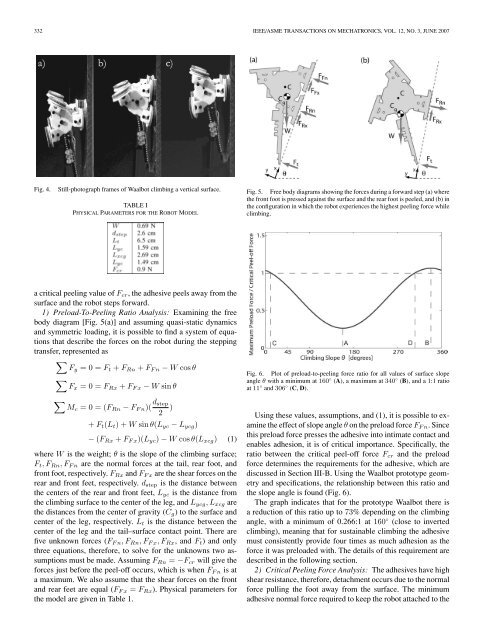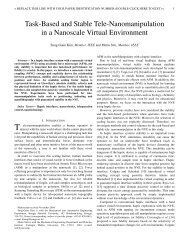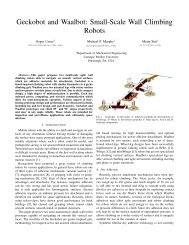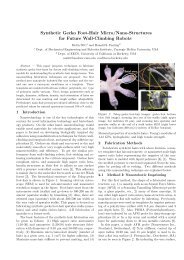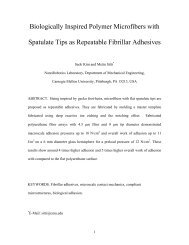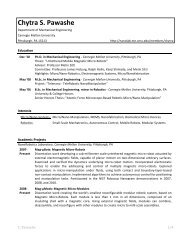Waalbot - NanoRobotics Lab - Carnegie Mellon University
Waalbot - NanoRobotics Lab - Carnegie Mellon University
Waalbot - NanoRobotics Lab - Carnegie Mellon University
Create successful ePaper yourself
Turn your PDF publications into a flip-book with our unique Google optimized e-Paper software.
332 IEEE/ASME TRANSACTIONS ON MECHATRONICS, VOL. 12, NO. 3, JUNE 2007<br />
Fig. 4.<br />
Still-photograph frames of <strong>Waalbot</strong> climbing a vertical surface.<br />
TABLE I<br />
PHYSICAL PARAMETERS FOR THE ROBOT MODEL<br />
Fig. 5. Free body diagrams showing the forces during a forward step (a) where<br />
the front foot is pressed against the surface and the rear foot is peeled, and (b) in<br />
the configuration in which the robot experiences the highest peeling force while<br />
climbing.<br />
a critical peeling value of F cr , the adhesive peels away from the<br />
surface and the robot steps forward.<br />
1) Preload-To-Peeling Ratio Analysis: Examining the free<br />
body diagram [Fig. 5(a)] and assuming quasi-static dynamics<br />
and symmetric loading, it is possible to find a system of equations<br />
that describe the forces on the robot during the stepping<br />
transfer, represented as<br />
∑<br />
Fy =0=F t + F Rn + F Fn − W cos θ<br />
∑<br />
Fx =0=F Rx + F Fx − W sin θ<br />
∑<br />
Mc =0=(F Rn − F Fn )( d step<br />
2 )<br />
+ F t (L t )+W sin θ(L yc − L ycg )<br />
− (F Rx + F Fx )(L yc ) − W cos θ(L xcg ) (1)<br />
where W is the weight; θ is the slope of the climbing surface;<br />
F t ,F Rn ,F Fn are the normal forces at the tail, rear foot, and<br />
front foot, respectively. F Rx and F Fx are the shear forces on the<br />
rear and front feet, respectively. d step is the distance between<br />
the centers of the rear and front feet, L yc is the distance from<br />
the climbing surface to the center of the leg, and L ycg ,L xcg are<br />
the distances from the center of gravity (C g ) to the surface and<br />
center of the leg, respectively. L t is the distance between the<br />
center of the leg and the tail–surface contact point. There are<br />
five unknown forces (F Fn ,F Rn ,F Fx ,F Rx , and F t ) and only<br />
three equations, therefore, to solve for the unknowns two assumptions<br />
must be made. Assuming F Rn = −F cr will give the<br />
forces just before the peel-off occurs, which is when F Fn is at<br />
a maximum. We also assume that the shear forces on the front<br />
and rear feet are equal (F Fx = F Rx ). Physical parameters for<br />
the model are given in Table 1.<br />
Fig. 6. Plot of preload-to-peeling force ratio for all values of surface slope<br />
angle θ with a minimum at 160 ◦ (A), a maximum at 340 ◦ (B), and a 1:1 ratio<br />
at 11 ◦ and 306 ◦ (C, D).<br />
Using these values, assumptions, and (1), it is possible to examine<br />
the effect of slope angle θ on the preload force F Fn . Since<br />
this preload force presses the adhesive into intimate contact and<br />
enables adhesion, it is of critical importance. Specifically, the<br />
ratio between the critical peel-off force F cr and the preload<br />
force determines the requirements for the adhesive, which are<br />
discussed in Section III-B. Using the <strong>Waalbot</strong> prototype geometry<br />
and specifications, the relationship between this ratio and<br />
the slope angle is found (Fig. 6).<br />
The graph indicates that for the prototype <strong>Waalbot</strong> there is<br />
a reduction of this ratio up to 73% depending on the climbing<br />
angle, with a minimum of 0.266:1 at 160 ◦ (close to inverted<br />
climbing), meaning that for sustainable climbing the adhesive<br />
must consistently provide four times as much adhesion as the<br />
force it was preloaded with. The details of this requirement are<br />
described in the following section.<br />
2) Critical Peeling Force Analysis: The adhesives have high<br />
shear resistance, therefore, detachment occurs due to the normal<br />
force pulling the foot away from the surface. The minimum<br />
adhesive normal force required to keep the robot attached to the


